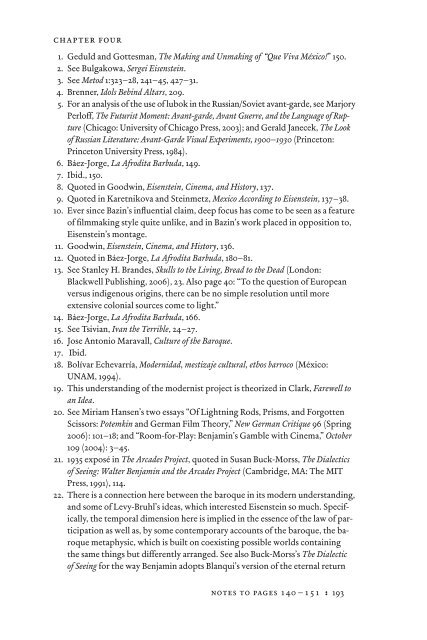In Excess: Sergei Eisentein's Mexico - Cineclub
In Excess: Sergei Eisentein's Mexico - Cineclub
In Excess: Sergei Eisentein's Mexico - Cineclub
Create successful ePaper yourself
Turn your PDF publications into a flip-book with our unique Google optimized e-Paper software.
chapter four<br />
1. Geduld and Gottesman, The Making and Unmaking of “Que Viva México!” 150.<br />
2. See Bulgakowa, <strong>Sergei</strong> Eisenstein.<br />
3. See Metod 1:323–28, 241–45, 427–31.<br />
4. Brenner, Idols Behind Altars, 209.<br />
5. For an analysis of the use of lubok in the Russian/Soviet avant-garde, see Marjory<br />
Perloff, The Futurist Moment: Avant-garde, Avant Guerre, and the Language of Rupture<br />
(Chicago: University of Chicago Press, 2003); and Gerald Janecek, The Look<br />
of Russian Literature: Avant-Garde Visual Experiments, 1900–1930 (Princeton:<br />
Prince ton University Press, 1984).<br />
6. Báez-Jorge, La Afrodita Barbuda, 149.<br />
7. Ibid., 150.<br />
8. Quoted in Goodwin, Eisenstein, Cinema, and History, 137.<br />
9. Quoted in Karetnikova and Steinmetz, <strong>Mexico</strong> According to Eisenstein, 137–38.<br />
10. Ever since Bazin’s infl uential claim, deep focus has come to be seen as a feature<br />
of fi lmmaking style quite unlike, and in Bazin’s work placed in opposition to,<br />
Eisenstein’s montage.<br />
11. Goodwin, Eisenstein, Cinema, and History, 136.<br />
12. Quoted in Báez-Jorge, La Afrodita Barbuda, 180–81.<br />
13. See Stanley H. Brandes, Skulls to the Living, Bread to the Dead (London:<br />
Blackwell Publishing, 2006), 23. Also page 40: “To the question of European<br />
versus indigenous origins, there can be no simple resolution until more<br />
extensive colonial sources come to light.”<br />
14. Báez-Jorge, La Afrodita Barbuda, 166.<br />
15. See Tsivian, Ivan the Terrible, 24–27.<br />
16. Jose Antonio Maravall, Culture of the Baroque.<br />
17. Ibid.<br />
18. Bolívar Echevarría, Modernidad, mestizaje cultural, ethos barroco (México:<br />
UNAM, 1994).<br />
19. This understanding of the modernist project is theorized in Clark, Farewell to<br />
an Idea.<br />
20. See Miriam Hansen’s two essays “Of Lightning Rods, Prisms, and Forgotten<br />
Scissors: Potemkin and German Film Theory,” New German Critique 96 (Spring<br />
2006): 101–18; and “Room-for-Play: Benjamin’s Gamble with Cinema,” October<br />
109 (2004): 3–45.<br />
21. 1935 exposé in The Arcades Project, quoted in Susan Buck-Morss, The Dialectics<br />
of Seeing: Walter Benjamin and the Arcades Project (Cambridge, MA: The MIT<br />
Press, 1991), 114.<br />
22. There is a connection here between the baroque in its modern understanding,<br />
and some of Levy-Bruhl’s ideas, which interested Eisenstein so much. Specifically,<br />
the temporal dimension here is implied in the essence of the law of partic<br />
ipation as well as, by some contemporary accounts of the baroque, the baroque<br />
metaphysic, which is built on coexisting possible worlds containing<br />
the same things but differently arranged. See also Buck-Morss’s The Dialectic<br />
of Seeing for the way Benjamin adopts Blanqui’s version of the eternal return<br />
notes to pages 140 – 151 : 193


